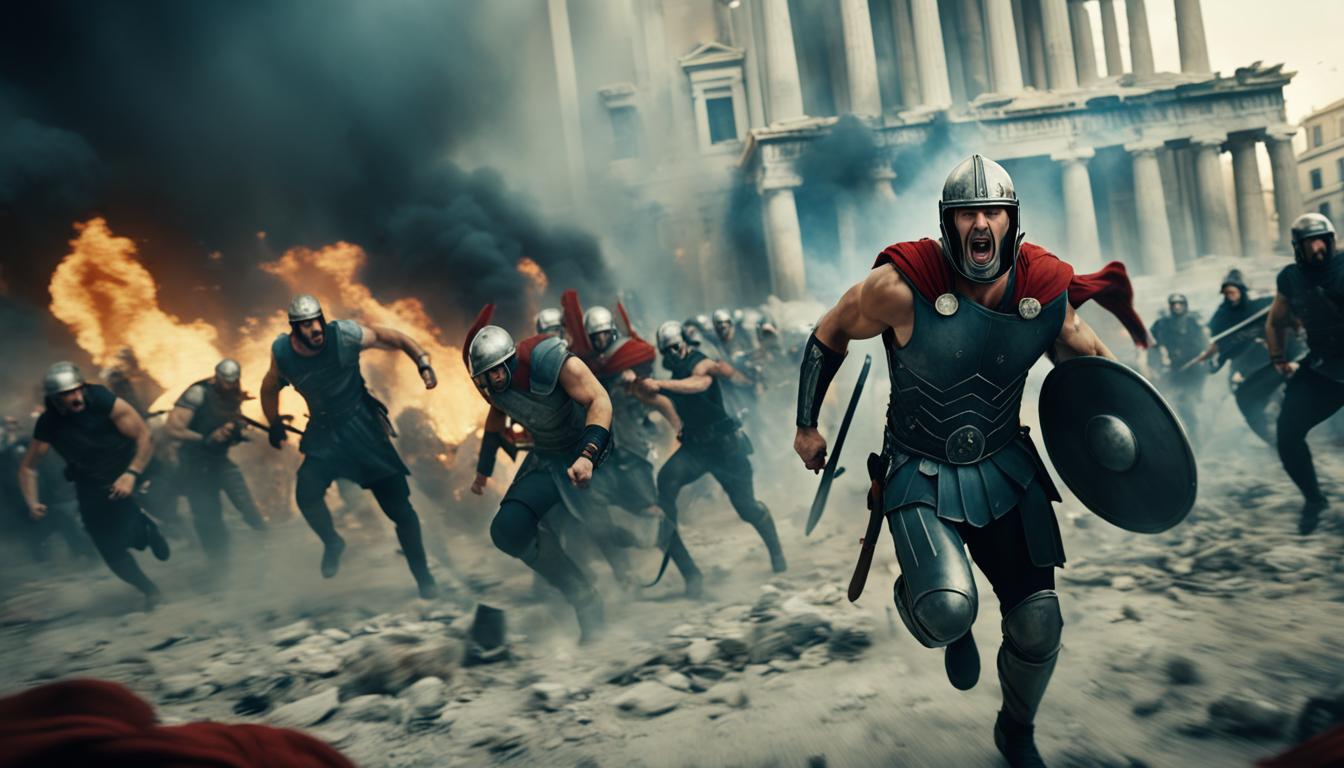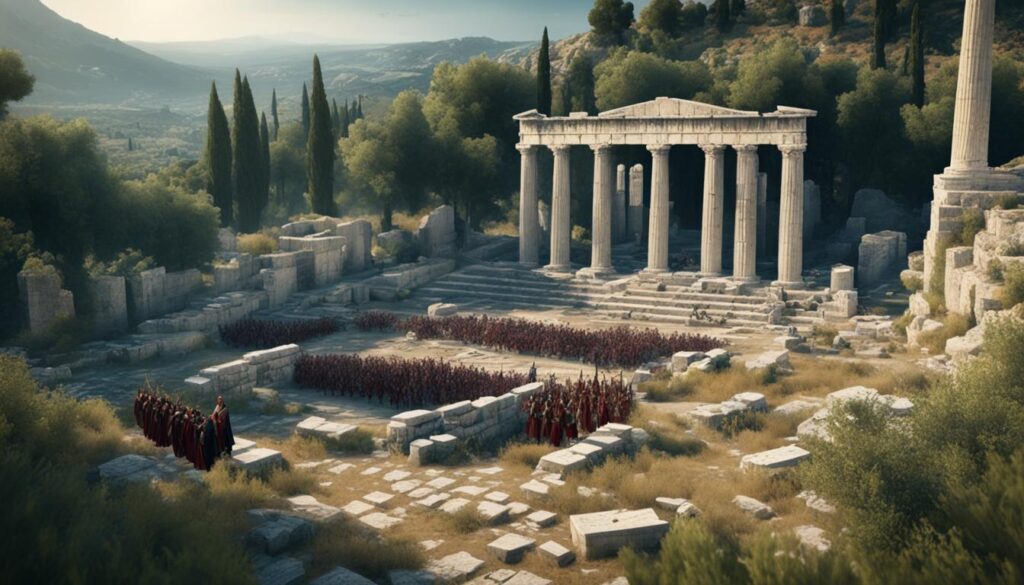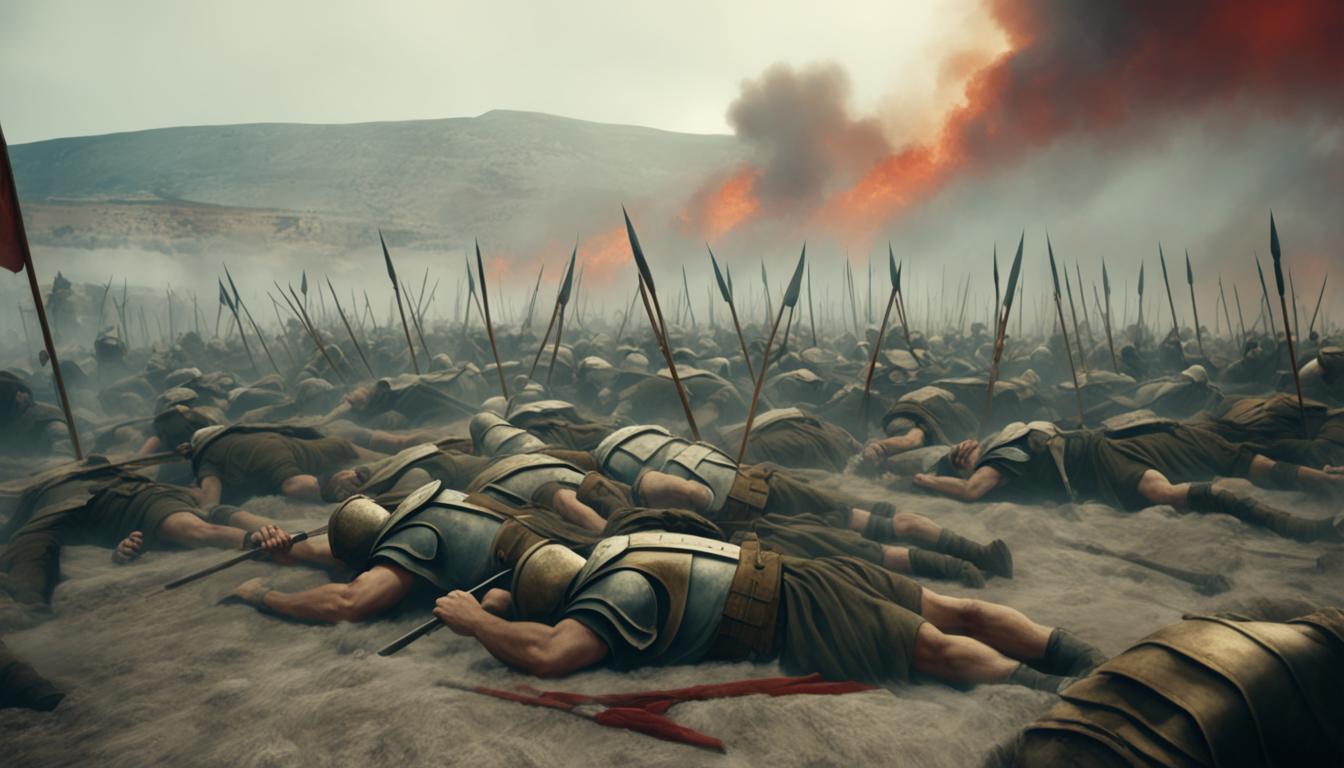Deep beneath the ancient port city of Phalaeron near Athens, a shocking discovery has been made by archaeologists. A mass burial site containing the remains of 80 men, 36 of whom were bound in iron shackles, has shed new light on a tragic event in ancient Greek history. These unsettling findings provide valuable insight into violent incidents that took place in ancient Greek society, revealing the dark realities of ancient Greek warfare and the sobering consequences of historical massacres.
Key Takeaways:
- The mass burial site in Phalaeron, near Athens, reveals the tragic events of a historical massacre in ancient Greece.
- Archaeologists discovered the remains of 80 men, with 36 of them bound in iron shackles.
- The victims are believed to have been followers of Cylon, a tyrant who attempted to take over Athens in the 7th century B.C.
- The finding provides insights into ancient Greek warfare and the social dynamics of ancient Greek society.
- This discovery highlights the importance of studying and preserving the historical events that shaped ancient Greece.
The Significance of the Mass Grave in Phalaeron
The mass grave discovered in Phalaeron is a remarkable find that provides valuable insights into the ancient burial practices and historical events of ancient Athens. This mass burial site, covering an area of 1 acre, has yielded over 1,500 skeletons, offering a window into the lives of individuals who lived during a tumultuous period in Greek history.
One of the most striking features of this mass grave is the presence of iron shackles on some of the skeletons, indicating a potential connection to an ancient Athenian revolt. The dating of the burial to the 7th century B.C. further supports this hypothesis, as it aligns with the period in which the infamous Coup of Cylon occurred.
The Coup of Cylon was a failed political uprising led by Cylon, an Olympic champion who sought to seize power in Athens. The revolt was a response to the social inequality and poor harvests that plagued the city during this era. The discovery of the mass grave in Phalaeron suggests that these skeletons were likely political rebels who met a tragic end during this tumultuous time.
This ancient Athenian revolt was a significant event that shaped the history of Athens and had long-lasting repercussions. The presence of a mass grave dedicated to individuals involved in the Coup of Cylon showcases the violent nature of the uprising and serves as a stark reminder of the political strife and social unrest in ancient Greece.
“The mass grave discovered in Phalaeron sheds light on the tragic events surrounding the Coup of Cylon and provides invaluable insights into the lives of ancient Athenians caught in the turmoil of political revolution.”
Furthermore, this discovery offers a unique perspective on the lives of working-class Athenians during the 7th century B.C. Through the excavation and analysis of these skeletons, historians and archaeologists can gain a deeper understanding of the social and economic conditions that shaped the lives of ordinary people during this pivotal period.
Ancient Greek Burial Practices
To better comprehend the significance of this mass grave, it is essential to examine the ancient burial practices prevalent during the 7th century B.C. Athenian society. During this time, the dominant burial tradition was inhumation, with bodies being placed in horizontal graves rather than vertical shafts. The deceased were often buried with grave goods and personal belongings, reflecting their social status and beliefs regarding the afterlife.
| Burial Practices | Description |
|---|---|
| Inhumation | In this method, the deceased were buried in horizontal graves. This practice was the most common form of burial during the 7th century B.C. Athenian society. |
| Grave Goods | Burial goods, such as pottery, jewelry, and weapons, were often interred with the deceased. These objects provided insights into the individual’s social status and cultural beliefs. |
| Community Burials | Mass graves, such as the one found in Phalaeron, suggest that certain events led to the burial of multiple individuals in a single location. These burials may have been connected to significant historical or sociopolitical events. |
The discovery of this mass grave in Phalaeron not only presents an opportunity to learn more about ancient Athenian burial practices but also sheds light on the lives of individuals who lived during a time of political unrest and upheaval. By studying these remains and the artifacts buried with them, archaeologists can piece together a more comprehensive understanding of this era in Ancient Greek history.
The Story of Cylon and His Failed Coup
Cylon, an Olympic champion from the 7th century B.C., was celebrated for his athletic prowess. His victory at the Olympic Games in 640 B.C. brought him fame and elevated his social status. With his newfound prestige, Cylon married the daughter of a nearby tyrant, solidifying his ties within the ruling elite.
However, as Athens faced growing discontent due to economic hardships and social inequalities, Cylon saw an opportunity to seize power. Around 632 B.C., he orchestrated a coup d’état, receiving support from his father-in-law’s soldiers. Cylon aimed to destabilize the existing political order and establish himself as a tyrant.
Despite his careful planning, the coup failed, and Cylon and his followers found themselves besieged in the Acropolis, the fortified citadel of Athens. Cut off from vital supplies, they eventually succumbed to starvation.
The city’s archon, Megacles, promised Cylon and his supporters safe passage if they surrendered. However, once they left the Acropolis, Megacles reneged on his word. The captured rebels were mercilessly slaughtered, marking the tragic end of Cylon’s revolt.
“Cylon’s failed coup serves as a stark reminder of the brutal political struggles in ancient Athens and the lengths to which the ruling elite would go to maintain their power.”
While Cylon himself may have been an Olympic champion, his attempt to seize power ultimately proved futile. The events surrounding his failed coup and subsequent massacre shed light on the volatile political climate of ancient Athens and the lengths to which factions would go to secure control.

The Tragic Consequences of Cylon’s Action
Cylon’s failed coup had far-reaching consequences, both in the immediate aftermath and for the future of Athenian democracy. The brutal massacre of his followers shocked the city and left an indelible mark on the collective consciousness. The act of destroying rebels seeking sanctuary in the sacred Acropolis was condemned as sacrilegious by the city authorities.
This event exacerbated the existing tensions in Athenian society, leading to further political reforms and eventually the establishment of a democratic system. The memory of Cylon’s revolt served as a cautionary tale, reminding subsequent generations of the dangers of political unrest and the importance of upholding democratic principles.
The Skeletal Evidence and Theories Surrounding the Massacre
The discovery of skeletal remains and iron shackles in the mass grave supports the theory that these individuals were political rebels involved in the Coup of Cylon. The presence of iron shackles indicates that these individuals were likely prisoners, restrained and executed as a result of their involvement in the coup. The good dental health observed in the skeletons suggests that they were relatively healthy individuals, possibly belonging to a working-class group.
The young age of the individuals further emphasizes their potential involvement in the rebellion, as younger individuals were more likely to support radical political movements.
However, it’s important to note that due to the scarcity of historical records from this period, it is challenging to conclusively link the skeletons to the coup. While the presence of iron shackles strongly suggests a connection to political rebellion, alternate explanations for the mass grave have not been ruled out entirely. Further analysis and research are required to gather more evidence and establish a definitive link between the skeletons and the Coup of Cylon.
| Skeletal Evidence | Theories |
|---|---|
| Iron shackles | Political rebels involved in the Coup of Cylon |
| Good dental health | Working-class Athenians |
| Young age | Potential support for radical political movements |
The presence of iron shackles on the skeletons provides compelling evidence that these individuals were political rebels who met a violent end. This discovery sheds light on the brutal consequences faced by those who challenged the established order in ancient Athens.
The Historical Significance of the Massacre
The massacre of Cylon’s followers in ancient Athens holds great historical significance, as it reveals the resistance of the aristocracy to political transformation and played a pivotal role in shaping the city’s political landscape. This tragic event took place approximately 2,500 years ago and ultimately led to the establishment of Athenian democracy.
When rebels sought sanctuary in the Acropolis, the act of massacring them was condemned as sacrilegious by the city authorities. The repercussions of this massacre extended throughout ancient Greek society, highlighting the profound impact it had on the collective consciousness of the time.
“The act of massacring rebels seeking sanctuary in the Acropolis was condemned as sacrilegious by the city authorities and had repercussions throughout ancient Greek society.”
Ancient Athens, known for its vibrant intellectual and cultural life, experienced significant political transformation in the aftermath of this massacre. It revealed the deep-rooted resistance of the aristocracy to any form of political change that could challenge their power and authority. The tragedy shed light on the need for a more inclusive and participatory system of governance.
The event played a crucial role in the subsequent development of Athenian democracy—a system that empowered the citizens of Athens and laid the foundation for the birth of Western democracy as we know it today. The Athenian democracy, born out of the struggle and sacrifice of those who fought for political reform, became a model for future democratic systems around the world.
This historical massacre serves as a reminder of the importance of political transformation and the pursuit of a fair and just system of governance. It stands as a testament to the enduring legacy of ancient Athens and the significant impact it has had on the course of human history.
Other Discoveries in the Area
The Faliron Delta region, where the mass grave was found, has been a treasure trove of archaeological discoveries. Numerous ancient burial sites dating back to the Archaic era have been uncovered, revealing fascinating insights into ancient Athenian society and burial practices. To date, over 136 burial sites have been explored, with more than 1,000 graves excavated.
These findings shed light on the customs and rituals surrounding death in ancient Greece. The meticulously documented archaeological excavations have provided researchers with valuable artifacts and funerary offerings, offering glimpses into the lives of those who lived centuries ago.
In addition to the burial sites, another remarkable discovery in the same area was the horse burial. This particular find stood out due to its exceptional preservation, providing a unique glimpse into ancient equine practices and the importance of horses in ancient Greek society. The horse burial adds to the overall archaeological significance of the Faliron Delta region.

Ancient Burial Sites Uncovered in the Faliron Delta Region
| Site Name | Number of Graves | Period |
|---|---|---|
| Site 1 | 50 | Archaic |
| Site 2 | 72 | Classical |
| Site 3 | 92 | Archaic |
| Site 4 | 40 | Hellenistic |
Ongoing Investigations and Future Plans
The recent discoveries at Phalaeron have sparked further investigations by the Central Archaeological Council. The importance of these findings in uncovering ancient Greek history has prompted discussions about the establishment of a museum on the site, dedicated to showcasing the artifacts and educating the public about the rich cultural heritage of ancient Greece.
The cultural ministry will make a decision regarding the construction of the museum, which aims to preserve and promote Greece’s ancient heritage for future generations. The museum would provide visitors with a unique opportunity to delve into the fascinating history of ancient Athens and gain a deeper understanding of the political and social dynamics that shaped the city.

The establishment of a cultural center and museum at Phalaeron would not only serve as a tribute to the past but also as a space for further research and exploration. It would provide a platform for scholars, archaeologists, and historians to collaborate and continue uncovering the mysteries of ancient Greece.
By preserving and sharing our ancient heritage, we can ensure that the stories of the past resonate with present and future generations, fostering a greater appreciation for our collective history.
Conclusion
The mass grave discovered in Phalaeron provides a poignant glimpse into a tragic event in ancient Greek history – the attempted coup of Cylon and the subsequent massacre of his followers. This archaeological finding offers significant insights into the social and political dynamics of ancient Athens during a period marked by political unrest.
The ongoing investigations surrounding the mass grave and the potential establishment of a museum underscore the importance of preserving and studying this historical event. By delving into the violent incidents that shaped ancient Greek society, we can gain a deeper understanding of Athens’ rich history and the archaeological significance of ancient Greek burials.
Through this discovery, we are able to paint a more comprehensive picture of Athens’ past, unraveling the complexities of political ideologies and social divisions that defined the era. The archaeological evidence further illuminates the upheaval and instability experienced by ancient Athenians, shedding light on historical events that continue to captivate our curiosity and fuel fascinating discussions in academic circles.
FAQ
What did the recent discovery in Phalaeron reveal?
What is the significance of the mass grave in Phalaeron?
Who was Cylon and what was his failed coup?
What theories surround the massacre and the mass grave?
What is the historical significance of the massacre?
What other archaeological discoveries have been made in the area?
Are there any ongoing investigations or future plans for the site?
What does the recent discovery reveal about ancient Greek history?
Source Links
- https://phys.org/news/2016-04-ancient-mass-graves-greece.html
- https://www.smithsonianmag.com/smart-news/shackled-skeletons-unearthed-in-greece-could-be-remains-of-slaughtered-rebels-180958812/
- https://www.dailymail.co.uk/sciencetech/article-3540584/Have-murdered-followers-Cylon-Skeletons-80-ancient-men-hands-bound-heads-belong-7th-Century-Greek-rebels.html

